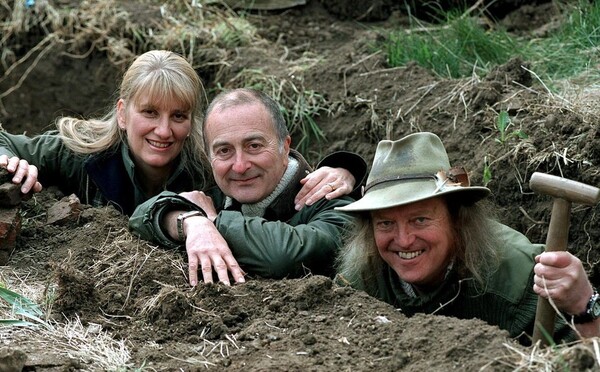
British Archaeology
- Mystery surrounds 800-year-old Leicester burial pit containing 123 bodieswww.theguardian.com Mystery surrounds 800-year-old Leicester burial pit containing 123 bodies
Researchers are baffled by 12th-century corpses uncovered at a heritage learning centre built in the garden of Leicester Cathedral after discovery of Richard III’s remains
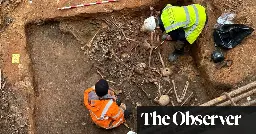
> In gardens a few metres from Leicester Cathedral, archaeologists have made a disturbing discovery. Their excavations have revealed a narrow vertical shaft filled with the remains of 123 men, women and children. > >It is one of the largest pit burials ever excavated in the UK, with subsequent research suggesting the bodies were dumped there more than 800 years ago, early in the 12th century. > >However, the reasons for putting the corpses in this tiny, ancient shaft remain a mystery. > > “Their bones show no signs of violence – which leaves us with two alternative reasons for these deaths: starvation or pestilence,” said Mathew Morris, project officer at Leicester University’s archaeological services. “At the moment, the latter is our main working hypothesis.” > >The excavations by Morris and his colleagues suggest the bodies were put into the shaft in three deposits, in rapid succession. “It looks as if successive cartloads of bodies were brought to the shaft and then dropped into it, one load on top of another in a very short space of time,” he said. “In terms of numbers, the people put in there probably represented about 5% of the town’s population.” > > ... > > The Anglo-Saxon Chronicles repeatedly mention great pestilences and fevers, severe mortality, and miserable deaths from hunger and famine in England from the mid-10th century through to the mid-12th century, said Morris. “This mass burial fits within this timeframe and provides physical proof of what was then occurring across the nation.”
- Gladiator knife handle found in Tyne ‘reflects spread of Roman celebrity culture’www.theguardian.com Gladiator knife handle found in Tyne ‘reflects spread of Roman celebrity culture’
Handle depicting secutor gladiator found on ‘edge of empire’ to go on display
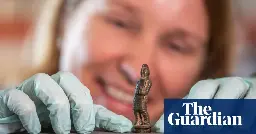
> A rare and pristine example of gladiator memorabilia found in the River Tyne is to go on display, shining light on a 2,000-year-old culture of celebrity and sex appeal. > >English Heritage said the copper alloy figurine would have been a decorative handle on a folding knife. Found near Corbridge, Northumberland, it provides proof that the superstar status of gladiators extended to the far edges of the Roman empire. > >“It is amazing, it’s absolutely pristine,” said Frances McIntosh, English Heritage’s collections curator for Hadrian’s Wall. It is rare to find any example of gladiator memorabilia in Britain but “to find such a well-preserved and interesting piece is remarkable”. > >“This beautifully made knife handle is a testament to how pervasive this celebrity culture was, reaching all the way to Hadrian’s Wall at the very edge of the Roman empire.” > >McIntosh said successful gladiators became celebrities and had sex appeal. “There are lots of rumours that you see of high society women falling in love with gladiators,” she said. “Often a slur on somebody was that they had been fathered by a gladiator, that they were the son of a gladiator because their mother was … you know.”
- Two newly discovered stone circles on Dartmoor boost ‘sacred arc’ theorywww.theguardian.com Two newly discovered stone circles on Dartmoor boost ‘sacred arc’ theory
Archaeologist Alan Endacott says area may have been site of henge monument similar to ‘earlier phase of Stonehenge’
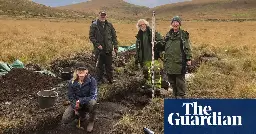
> Two neolithic stone circles have been discovered on Dartmoor, adding credibility to the theory that a “sacred arc” of monuments was built in the heart of the wild Devon uplands. > >One of the circles appears to have similar features to Stonehenge, while the second sits slightly outside the sweep of the arc and could have served as a gateway used by pilgrims travelling to the area. > >The discovery of the two rings is a result of a lifetime of work by Alan Endacott, a Devon archaeologist and stained glass artist who in 2007 unearthed the presence of the highest stone circle in southern England, Sittaford on Dartmoor > >It was the first stone circle to be discovered on the moor for more than a century and reinforced the sacred arc theory. Rather than resting on his laurels, Endacott has kept on searching for more circles and been rewarded with two further finds. > > ... > > Endacott believes a sacred arc was intended to ring the high ground in the centre of the moor. “Dartmoor would have been very different then, there would have been a lot more forest cover. So possibly they were markers in the landscape, they recognised the higher ground and wanted to kind of enclose it for some reason.”
- Cornish monument is 4,000 years older than was thought and ‘without parallel’www.theguardian.com Cornish monument is 4,000 years older than was thought and ‘without parallel’
Original purpose of King Arthur’s Hall is a mystery and archaeologists say it is unique in Europe

> An enigmatic stone and turf structure on Bodmin Moor that was previously thought to be a medieval animal pen has been found to be 4,000 years older – and unique in Europe. > >The rectangular monument was built not in the early medieval period to corral livestock, as recorded by Historic England, but rather in the middle Neolithic, between 5,000 and 5,500 years ago, archaeologists have discovered. > >Nothing like it is known in Britain or farther afield, according to experts, meaning that the original purpose of the monument known as King Arthur’s Hall is a mystery. > > “There isn’t another one of these anywhere,” said the lead archaeologist, James Gossip. “There is nothing built at that time or subsequently in prehistory that is a rectangular earth and stone bank with a setting of stone orthostats around the interior. There is no other parallel.” > >The so-called “hall”, which sits on the western side of Bodmin Moor near Helstone in Cornwall, consists of a banked enclosure measuring 49 metres by 21 metres, lined on the inside with 56 standing stones up to 1.8 metres tall.
- Remembering the discovery of the Lindow Man in Cheshirewww.knutsfordguardian.co.uk The archaeological discovery in Cheshire that made global headlines
The Lindow Man is considered one of the most important UK archaeological finds of the 20th century.
> 'In amongst the shattered peat was a perfectly preserved human foot – brown and complete with toenails. > >Wilmslow in 1984 was a medium-sized, old-fashioned town with its fair share of furrier and celebrities, plus a couple of pharmaceutical companies to keep it rooted in the 20th century – not the kind of place where anyone would have guessed the UK’s most significant archaeological discovery of the century would be made. > > It was there, in the rickety offices of the Wilmslow World on Water Lane one hot August day I received the call that would lead to the town being assured a place in the annals of ancient history, through the discovery of the UK’s first bog body to be removed intact from the peat. > > ... > > Andy Mould and Eddie Slack had been watching the peat coming down a huge conveyor belt when one of them had spotted a lump of peat: 'like a rugby-ball,' they told me. One picked it up to lob at the other, who dropped it. In amongst the shattered peat was a perfectly preserved human foot – brown and complete with toenails. > >According to the peat diggers, the foot had been cut – as if by a blade. I wondered if there was a body out there missing a foot. > >I was soon riding out, on a miniature train with temporary rails, onto the centre of the Moss to find out. > > ... > > On the way back to the sheds, I told the peat workers to stop the diggers for 24 hours, while I brought ‘an expert’ to look at the peat facer we’d just visited. With the arrogance of youth, I told them I would square it with their employers. > > Naturally had no idea who I would summon, but I’d been on a dig during my university vacation (for social rather than academic interest) and had heard the term ‘County Archaeologist’ bandied about. Without the internet to assist, it took a few phone calls to locate a certain Richard (Rick) Turner, in his first week in the job. > > ... > > When Rick rang again, two days later (Friday, August 3), I could tell from his voice that this academic was excited. He told me he’d walked as directed up to the peat face, had simply stuck in his trowel and a bone had fallen out, which he immediately identified as human. He was convinced the foot belonged to a body buried there, he’d reported his discovery to the police in Wilmslow, and had been given the weekend to assemble a team of archaeologists to remove the body intact from Lindow Moss. > >Then Rick said these unforgettable words: “I’m not going on the record with this, but I think this is a very important find, and will prove to be ancient.' He was guessing at 2,000 years ancient.
- Unique Bronze Age hoard from Peebles saved for the nationwww.bbc.com Unique Bronze Age hoard from Peebles saved for the nation
Hundreds of items which had lain untouched for 3,000 years were found by a metal detectorist near Peebles.
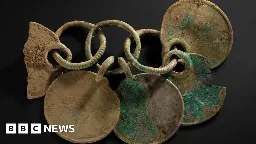
> A hoard of Bronze Age artefacts unearthed by a metal detectorist in the Borders has been saved for the nation by National Museums Scotland. > >It has acquired the Peebles Hoard, which had lain undisturbed for 3,000 years before it was discovered in 2020. > >Efforts have now started to secure funding for continued research and conservation of the collection, which includes more than 500 pieces. > >National Museums Scotland (NMS) said the man who found it had received a five-figure sum. > > Senior curator Dr Matthew Knight said it shed new light on Bronze Age communities in Scotland. > >The hoard has been described as one of the most significant ever found in the country. > > ... > > NMS said it represented a "complex set of material, some of which has no archaeological parallel anywhere in western Europe". > >"This includes many unique artefacts, the use of which is yet to be discovered and could transform our understanding of life in Bronze Age Scotland," it added. > > ... > > The hoard was found in 2020 by metal-detectorist Mariusz Stepien, who alerted the Treasure Trove Unit. > >That allowed experts to coordinate a complex retrieval process which involved removing the hoard from the ground in a single block which was then CT scanned.
- Archaeologists reveal how ‘exceptionally rare’ Bronze Age tool was so well preservedwww.independent.co.uk Archaeologists reveal how ‘exceptionally rare’ Bronze Age tool was so well preserved
The rare Bronze Age spade was discovered during a coastal habitat project in Poole Harbour
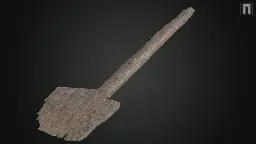
> Archaeologists have unearthed an exceptionally rare wooden spade dating back approximately 3,500 years. > >Experts from Wessex Archaeology discovered the treasure during a project aimed at creating coastal habitats in Poole Harbour, Dorset. > > The find is considered one of the oldest and most complete wooden tools found in the UK, with preliminary analysis confirming its Bronze Age origins. > >Experts believe the waterlogged conditions of the excavation site contributed to the spade’s preservation, providing insights into how ancient communities interacted with the environment. > >The spade’s preservation is unusual, as organic materials like wood typically do not survive for millennia. > > Only one other Bronze Age wooden tool, the Brynlow Shovel, found in an ancient mine in Cheshire, has been discovered in the UK, the team said.
- More than 4,500 bodies discovered in unmarked mass grave in Bristolwww.gloucestershirelive.co.uk More than 4,500 bodies discovered in unmarked mass grave in Bristol
The shocking discovery was made by archaeologists excavating the site of one of the city's most notorious workhouses

> The graves of more than 4,500 people have been discovered in the grounds of a historic building on the edge of Bristol, which archaeologists say reflects a ‘dark chapter’ in the city’s history. > >The remains were unearthed over five years in a dig at the site of the former Blackberry Hill Hospital in Stapleton in Bristol, and revealed in a report released this week by the archaeologists. > > Cotswold Archaeology were commissioned by developers Vistry, who are developing the site for housing, to investigate the historic site, which has had many roles in the city’s history. > > And now, having completed the first part of the archeological excavation, and analysed the findings, Cotswold Archaeology have now reported back to Vistry what they found - and the results are stunning. > > The site was first developed in the late 1700s, when Stapleton Prison was built there. Over the next few decades, it housed prisoners of war from Britain’s conflicts with France, Spain, Holland and the US, but as Bristol grew and the conflicts ended, a new need was more pressing - as a hospital. Its location on the edge of the city meant it was converted into a hospital during the 1832 cholera outbreak, but within five years had been converted again into the Stapleton Workhouse. > >From then until the early 20th century, the workhouse was where the poor, destitute, sick and anyone who couldn’t look after themselves were sent, and very often they died there, and were buried in unmarked graves - which have now been discovered, more than 100 years later. > >“One of the most striking elements of the excavation is the discovery of more than 4,500 graves,” said Rosanna Price, Cotswold Archaeology’s engagement manager. “These primarily date from the workhouse period, from 1837 to the late 19th century. Some burials may even date back to the site’s earlier function as a prisoner-of-war camp.
- Coin trove from time of Norman conquest becomes England’s highest-value findwww.theguardian.com Coin trove from time of Norman conquest becomes England’s highest-value find
£4.3m hoard acquired for the nation by South West Heritage Trust will be displayed at British Museum next month

- West Deeping archaeological dig unearths 6,000 years of historywww.bbc.com West Deeping archaeological dig unearths 6,000 years of history
Excavations in West Deeping revealed a Roman settlement as well as Neolithic and Bronze Age finds.
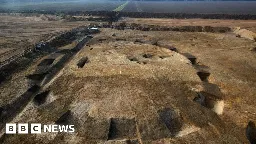
> An archaeological dig of a quarry in Lincolnshire has uncovered evidence of settlements and agriculture spanning 6,000 years. > >Excavations of the West Deeping quarry revealed a Roman settlement as well as Neolithic and Bronze Age finds. > >The oldest artefacts included pottery used for cooking and eating. > >A free exhibition of some of the finds will be on display in West Deeping village hall on Saturday, from 13:00 to 17:00 BST. > >Hannah Barrett, a project officer with the Cambridge Archaeological Unit, said: "This site isn't just Neolithic, Bronze Age or Roman, we have all of the periods right through to Saxon in the 6th Century. > >"All of these periods are represented and every single one has a good story to tell," she said. > >"I think that's what's so fascinating about." > >She added evidence dating back to the later Neolithic period included "the largest assemblage" of pottery ever found in East Anglia or the East Midlands.
- Roman-Era settlement and Medieval longhouse unearthed in Waleswww.sci.news Roman-Era Settlement and Medieval Longhouse Unearthed in Wales | Sci.News
A team of archaeologists from the University of Chester, Heneb: the Trust for Welsh Archaeology and the Portable Antiquities Scheme has uncovered the ruins of a Roman settlement and a rare Medieval longhouse in Wrexham, North East Wales.

> The archaeologists unearthed structural features and materials dating to the Roman era and the early Medieval period during an excavation at a site near the Holt Roman tile and pottery works in Wrexham, North East Wales. > >They also found the structure of an early Medieval longhouse — a long, narrow, building for communal dwelling. > >“We were very hopeful of finding evidence of Roman life due to previous discoveries and geophysical surveys in the area, not to mention the presence of the legionary tileworks a few fields away, but did not expect our excavations to uncover what is believed to be an early Medieval longhouse,” said Dr. Caroline Pudney, senior lecturer in archaeology at the University of Chester. > >“The discovery of a Roman settlement is extremely important in building a bigger picture of Roman Wrexham and although early Medieval longhouses have been found in other parts of Wales, to unearth evidence of such a building in North East Wales is extremely rare.”
- Remains of Roman town discovered in Cambridgeshire given protected statuswww.theguardian.com Remains of Roman town discovered in Cambridgeshire given protected status
Evidence of highly organised urban settlement found during survey work for solar farm near Great Staughton
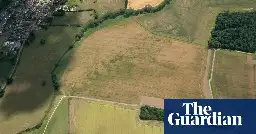
cross-posted from: https://lemmy.world/post/20367335
> Evidence of highly organised urban settlement found during survey work for solar farm near Great Staughton > > The well-preserved remains of a Roman town discovered during survey work for a solar farm in Cambridgeshire have been given heritage protection status as a scheduled monument. > > The buried archaeological features of the settlement near Great Staughton extend across 31 hectares (77 acres) and include ditches, pits, post holes, and gravel surfaces that represent roads or yard areas. > > The remains show the extensive streets and buildings of a highly organised Roman settlement of an urban character, Historic England said. > > Recovered artefacts include pottery, animal bone, glass, copper alloy objects, iron objects, coins and shells. Evidence also suggests there may have been pottery kilns and blacksmith forges.
- Dorset ‘Stonehenge’ under Thomas Hardy’s home given protected statuswww.theguardian.com Dorset ‘Stonehenge’ under Thomas Hardy’s home given protected status
Enclosure found under late novelist’s garden is older than Salisbury monument and wins national recognition

>When the author Thomas Hardy was writing Tess of the D’Urbervilles in 1891, he chose to set the novel’s dramatic conclusion at Stonehenge, where Tess sleeps on one of the stones the night before she is arrested for murder.
>What the author did not know, as he wrote in the study of his home, Max Gate in Dorchester, was that he was sitting right in the heart of a large henge-like enclosure that was even older than the famous monument on Salisbury Plain.
>Though invisible at ground level after millennia of ploughing, the enclosure still survives under Hardy’s garden. It has now been given protection by the government as a scheduled monument, recognising its status as a nationally important site...
- 'Significant' Anglo-Saxon Dogger Bank finds to go on displaywww.bbc.com 'Significant' Anglo-Saxon Dogger Bank finds to go on display
Archaeologists say they made "regionally significant" discoveries during excavations in Holderness.
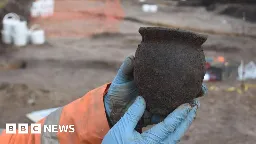
> Archaeologists have uncovered "significant" Anglo-Saxon finds across Holderness as cables are laid for the Dogger Bank offshore wind farm. > >The discoveries include remnants of an Anglo-Saxon long hall structure between Beeford and Skipsea, as well as artefacts from a site in Ulrome. > >The findings indicate Anglo-Saxons probably lived and farmed in this landscape over multiple phases between the 5th and 11th centuries. > >Community engagement manager for Dogger Bank Wind Farm, Rachel Lawrence, said: "Safeguarding historical evidence has been a critical part of our preparation work on Dogger Bank Wind Farm." > >She added: "We’re delighted we’re now able to share these exciting findings with the people who live in the towns and villages where this work was undertaken." > > ... > > The early medieval discoveries were unearthed by archaeologists working on a 30km corridor that houses the underground cables transmitting energy from Dogger Bank Wind Farm in the North Sea to the wind farm’s two onshore stations near Beverley. > >Archaeologists described the finds as a "regionally-significant discovery". > >Project manager for AOC Archaeology, Rebecca Jarosz- Blackburn, said the most "surprising and rewarding discovery" was the Anglo-Saxon long hall and associated field systems recorded near Beeford, which she said "represents some of the most extensive evidence from the period in the Holderness region".
- Stonehenge tale gets ‘weirder’ as Orkney is ruled out as altar stone originwww.theguardian.com Stonehenge tale gets ‘weirder’ as Orkney is ruled out as altar stone origin
Weeks after revelation that megalith came from Scotland, researchers make surprise discovery
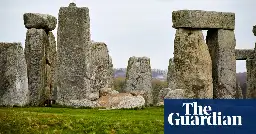
"The plot has thickened on the mystery of the altar stone of Stonehenge, weeks after geologists sensationally revealed that the huge neolithic rock had been transported hundreds of miles to Wiltshire from the very north of Scotland.
That discovery, described as “jaw-dropping” by one of the scientists involved, established definitively that the six-tonne megalith had not been brought from Wales, as had long been believed, but came from sandstone deposits in an area encompassing the isles of Orkney and Shetland and a coastal strip on the north-east Scottish mainland.
Many experts assumed that the most likely place of origin was Orkney, based on the islands’ rich neolithic culture and tradition of monument building.
But a separate academic study has now found that Orkney is not, in fact, the source of the altar stone, meaning the tantalising hunt for its place of origin goes on..."
- ‘Remarkable’ Pictish ring discovered by volunteerwww.bbc.com ‘Remarkable’ Pictish ring discovered by volunteer
The ring is thought to have lain undiscovered for more than 1,000 years at Burghead in Moray.
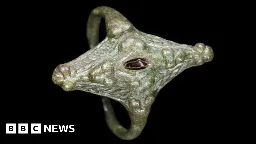
> A "remarkable" Pictish ring thought to be at least 1,000 years old has been discovered by a volunteer on a dig in Moray. > >The find was made by John Ralph at the site of a fort in Burghead. > >It is thought the settlement was a significant seat of power within the Pictish kingdom between AD500 and AD1000. > >Delighted Mr Ralph - who described himself as an "enthusiastic volunteer" - was on a dig being led by the University of Aberdeen. He felt like a "striker scoring a goal" with the find.
- Archaeologists uncover new evidence of Merlin legend in Scotlandwww.thenational.scot Archaeologists uncover 'dark' new evidence of Merlin legend in Scotland
ARCHAEOLOGISTS have shed new light on the legend of Merlin and the magician's Scottish connections.
> The village of Drumelzier in the Borders has long been associated with Merlin. > >According to Vita Merlini Sylvestris (the Life of Merlin of the Forest) — a medieval manuscript held by the British Library — Merlin was reportedly imprisoned there and buried on the banks of the Tweed in the 7th century. > >In 2022, a team of volunteers drawn from across Scotland and led by GUARD Archaeology set out to investigate the archaeological roots of this local legend. > >Now, the results of the work have been published with experts revealing that there may indeed be some truth to the reports of Merlin's death in Scotland. > > A geophysics survey revealed that there is an archaeological feature resembling a grave near to the reputed location of Merlin’s Grave at Drumelzier. > >An excavation of Tinnis Fort, which overlooks Merlin’s Grave, also found that this prominent hillfort was occupied around the late 6th and early 7th centuries AD, precisely when the story was set. > >Archaeologists said the fort has the hallmarks of a lordly stronghold of the time. > > "The Drumelzier legend contains pre-Christian customs, ancient Cumbric names and was associated with local sites where archaeology now shows could credibly have given rise to the story," said GUARD Archaeology CEO Ronan Toolis, who led the project. > > ... > > "Unlike the classic depiction of Merlin as the wise and respected adviser to King Arthur, the Drumelzier legend paints a much darker picture. > >"That of a rather pitiful fellow prone to uttering nonsensical riddles and bewildering prophecies, and kept prisoner by an obscure petty tyrant of a forgotten kingdom, before dying a gruesome death, the victim of royal intrigue."
- ‘Amazing’ Viking-age treasure travelled half the world to Scotland, analysis findswww.theguardian.com ‘Amazing’ Viking-age treasure travelled half the world to Scotland, analysis finds
Lidded vessel is star object in rich Galloway Hoard and came from silver mine in what is now Iran
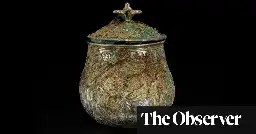
> It is a star object of the Galloway Hoard, the richest collection of Viking-age objects ever found in Britain or Ireland, buried in AD900 and unearthed in a field in Scotland. Now a lidded silver vessel has been identified as being of west Asian origin, transported halfway around the world more than 1,000 years ago. > > When it emerged from the ground a decade ago, the vessel was still wrapped in its ancient textiles, whose survival is extremely rare. Its surface could be seen only through X-ray scans. Since then, the textiles have been partially removed and preserved and the vessel has had laser cleaning to remove green corrosion over much of its silver surface. It has also undergone scientific analysis. > >Details of a “remarkable” design that includes crowns, fire altars and creatures including leopards and tigers can be seen for the first time. > >The imagery is linked to the iconography of Zoroastrianism, the state religion of the Sasanian empire, the last Persian empire before the early Muslim conquests from AD632. Scientific analysis shows that the silver from which it was made came from a mine in modern-day Iran. > > The hoard was discovered in 2014 by a metal-detecting enthusiast on what is now Church of Scotland land at Balmaghie, Kirkcudbrightshire. Described as one of the century’s most important UK archaeological finds, it contained more than 5kg of silver, gold and other materials, with objects ranging from a Christian pectoral cross to brooches.
- Archaeologists uncover the real story of how England became Englandwww.smithsonianmag.com Archaeologists Uncover the Real Story of How England Became England
New research is revealing how the Sceptered Isle transformed from a Roman backwater to a mighty country of its own
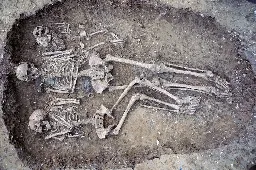
> Since the Renaissance, scholars have been engaged in a curious and feverish debate over where the people who populate England came from. Did they arrive as conquerors, as Gildas would have it? Or by a more gradual and peaceful migration? The answer matters because it provides an explanation for a perplexing reality: In a remarkably short three centuries after the Roman occupation, Britain was transformed into a dramatically different kind of place. > >Under Roman administration, Britain was largely urban. People lived in tile-roofed stone buildings in towns connected by roads; they boasted a standing army and a coinage system. Native Britons spoke an indigenous Celtic language and probably some Latin. By the 700s, things had changed entirely: Inhabitants lived mostly in country hamlets in wood-and-thatch homes resembling Grubenhäuser, those partly sunken houses typical of northern Germany and southwest Denmark. With the empire gone, many workers, from builders to vintners to smiths to perfumers, simply no longer had a market for their products or services, so the only way to survive was subsistence farming. In this way, the Britons produced what they needed, and they bartered for the rest. The things they made, jewelry or pots, drew on both continental and indigenous traditions but were uniquely theirs. Most striking, they had created a new national identity and were speaking a new language, the earliest form of English. > > But exactly how was the Roman Britain of 400 transfigured into the radically different country we now call England—all in less than 300 years? Recent scholarship presents an intriguing, and persuasive, case for the migration hypothesis. Analyzing DNA from hundreds of Anglo-Saxon-era bones in England and in northwest Europe, a paper in the journal Nature has concluded that as much as 76 percent of ancestry in eastern medieval England came from what is now Germany and Scandinavia. Meanwhile, archaeologists continue to uncover artifacts in Anglo-Saxon cemeteries that arguably weigh heavily against the theory of origin-by-conquest; indeed, no graves suggesting wealth have been linked to any purely Germanic settlers. The findings suggest something rather remarkable: that some of the most precipitous shifts in social and material culture can come not from war but from peace. > > ... > > If there had been a conquest and a resulting upper class of Germanic warriors, you’d expect to see two distinct genetic pools. Not so. “This paper is paradigm-shifting,” says Oxford archaeologist Helena Hamerow, who reviewed the group’s work for Nature. “Clearly the native Britons were not nearly exterminated and/or driven out,” she adds, “but many must have intermarried with and lived amongst immigrants and their descendants.”
- Boy finds Roman-era gold military bracelet while walking dog in UKwww.livescience.com Boy finds Roman-era gold military bracelet while walking dog in UK
The newfound bracelet was likely awarded for a feat of valor carried out during Rome's conquest of Britain.
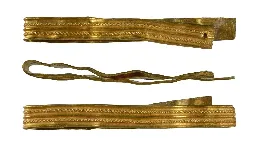
> While walking his dog with his mom, a 12-year-old boy in the U.K. made an unexpected discovery in a field — not a stick for his dog or an interesting rock, but a first-century gold bracelet from Roman Britain. > > Unlike most other jewelry from the Roman era, the lustrous bracelet probably wasn't worn by a woman, researchers later surmised. Instead, it likely belonged to a man who had received the accessory as a military honor, likely an "award for bravery," according to a statement from the local Chichester District Council. > >The cuff bracelet has been described as "exceptional" and "relatively rare in Roman Britain," especially because it's crafted from gold, according to the statement. > > ... > > A newly announced analysis of the bracelet revealed that it was made from sheet gold with raised moldings, and it dates to the first century A.D., not too long after Roman emperor Claudius invaded Britain in A.D. 43.
- Bronze Age burial chamber unearthed on Dartmoorwww.bbc.co.uk Bronze Age burial chamber unearthed on Dartmoor
The excavation took place at one of the remotest hills on Dartmoor.
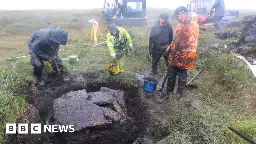
"Archaeologists have unearthed a "stunning" Bronze Age burial chamber on one of Dartmoor’s most isolated hills.
Experts discovered a stone-built box, sometimes known as a cist, at Cut Hill during a three-day dig earlier this month.
Radiocarbon dating of charcoal found inside suggests the chamber, used to bury the dead during prehistoric times, is about 3,900 years old.
Dartmoor National Park Authority (DNPA), which led the project, said the discovery had been prompted by reports of a feature being visible in the peat..."
- Excavation unearths a thousand years of historynation.cymru Excavation unearths a thousand years of history
A piece of the jigsaw puzzle that could unlock 1,000 years of history at a north Wales heritage site has been unearthed – suggesting that local Britons may have lived ‘in harmony’ with the Romans. An excavation has led to the discovery of a horse bridle mount dating back to the late Iron Age at the ...
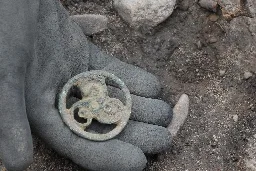
> A piece of the jigsaw puzzle that could unlock 1,000 years of history at a north Wales heritage site has been unearthed – suggesting that local Britons may have lived ‘in harmony’ with the Romans. > >An excavation has led to the discovery of a horse bridle mount dating back to the late Iron Age at the Greenfield Valley Heritage Park in Flintshire. > >The artefact, which is up to 2,000 years old, was found within the remains of a newly discovered settlement that likely belonged to the Iron Age Deceangli tribe but appears to have continued into the early Roman period. > >The region occupied by the Celtic clan, which spread as far west as the River Conwy and included Denbighshire, Flintshire, and Wrexham, was rich in lead and silver, materials highly prised by the Romans.
- Archaeologists uncover 2,000-year-old prehistoric settlement on the site of HMP Highland in Invernesswww.inverness-courier.co.uk Archaeologists uncover 2,000-year-old prehistoric settlement on the site of HMP Highland in Inverness
The excavation has led to the discovery of a roundhouse settlement relating to Iron Age and Bronze Age occupation of the site.
> Archaeologists have uncovered a 2,000-year-old prehistoric settlement as part of development work on the site of the new HMP Highland in Inverness. > >The excavation has led to the discovery of a roundhouse settlement relating to Iron Age and Bronze Age occupation of the site, which also contained earlier prehistoric remains dating back to at least 3,000 BC. > >A wide variety of prehistoric remains were found at the HMP Highland site, including occupation areas related to domestic and industrial activities and structural evidence from the roundhouses and other timber structures. > > The settlement consisted of 16 roundhouses that survived as circular alignments of postholes, where timber posts had once supported substantial hut buildings. Some of the house sites had been enclosed by palisade fencing to protect the interior.
- Amateur archaeologists uncover Bronze Age grave in Wiganwww.bbc.com Amateur archaeologists uncover Bronze Age grave in Wigan
A local archaeological society has made what they believe is a rare discovery for the region.
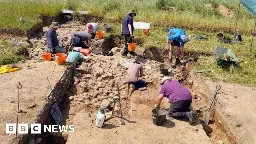
> An ancient monument uncovered by a team of amateur archaeologists is exciting and puzzling the experts. > >Three years of excavations on the side of a hill in Aspull, Wigan have revealed a Bronze Age burial site surrounded by a ring shaped ditch that is believed to be a religious henge. > >The find is thought to be unique to the region and potentially of national importance. > > ... > >The archaeologists working at the site believe it marks two different points in history. > >"From the Neolithic Stone Age period it would have been a ritual holy site," Mr Aldridge said. > >"But then at a later date, when the Bronze Age people came along, they thought it was something special and decided to create their own funerary monument in the middle of it. > >"You do get Bronze Age barrows in the north, but they’re quite rare. You usually find them down south in places like Wiltshire. > >"And you have to go to the Lake District, Yorkshire, Derbyshire or North Wales before you get henge monuments or Neolithic Stone Age activity.
- Stonehenge’s giant Altar Stone came all the way from north-east Scotland – here’s how we worked out this astonishing new findingtheconversation.com Stonehenge’s giant Altar Stone came all the way from north-east Scotland – here’s how we worked out this astonishing new finding
This is the longest known journey for any stone used in a Neolithic monument.

- Stonehenge: Central Altar Stone from Scotland not Waleswww.bbc.com Stonehenge: Central Altar Stone from Scotland not Wales
Stonehenge's famous Altar Stone came from Scotland not Wales as previously thought, new analysis shows.

- Hidden mosaic discovered at Roman sitewww.bbc.com Hidden mosaic discovered at Wroxeter Roman site
The mosaic depicting dolphins and fish is likely to have been commissioned by someone wealthy.
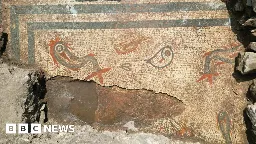
> A 2,000-year-old mosaic has been discovered during excavations at a Roman site in Shropshire. > >The piece at Wroxeter Roman City depicts brightly-coloured dolphins and fish. > >It was uncovered during work to search for the main civic temple. > >"Our excavations were in hope of discovering the walls of this building, but we never suspected we would find a beautiful and intact mosaic, which had lain hidden for thousands of years," said Win Scutt, from English Heritage.
- Plant remains survived 3,000 years on Bronze Age braceletswww.bbc.com Remains survived 3,000 years on Rosemarkie Bronze Age bracelets
The jewellery was discovered at a construction site on the Black Isle.
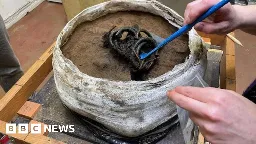
> Rare remains of plants have been found on Bronze Age jewellery uncovered in the Highlands. > >Archaeologists said the fibrous cords used to knot together bracelets had survived for about 3,000 years. > >The ancient hoard, which appears to have been carefully buried, was found at a building site in Rosemarkie on the Black Isle where a Bronze Age village once stood. > >It contained nine bronze bracelets and necklaces buried sometime around 1000 BC. > > ... > > Rachel Buckley, who led the work, said: "While there are other examples of hoards where it has been postulated that items were bound together due to their positioning, the vegetation in the Rosemarkie hoard has survived for approximately 3,000 years, proving that these artefacts were held together." > >Archaeologists said the finds would help to improve knowledge of the lives, beliefs and deaths of Bronze Age people in the Highlands.
- A Playing Field Yields Oldest Houses in Walesnews.artnet.com A Playing Field Yields Oldest Houses in Wales | Artnet News
Under a playing field at a park, researchers have found the remains of what they deem to be the oldest houses in Cardiff.
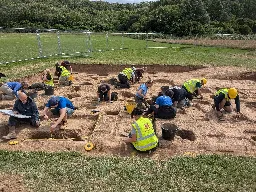
>A large open space in in Trelai Park that had been used as a playing field since 1933 yielded a treasure trove of prehistoric artifacts during a 2022 land survey conducted by a local school that was building a sports field in a corner of the park. Upon the archaeological site’s discovery, the Caerau and Ely Rediscovering Heritage Project (CAER), an organization promoting community involvement in archaeological research, began collaborations with Cardiff University to excavate the area. > > Archaeologists initially expected the discovery would shed new light on everyday life in the region between the late Iron Age and early Roman Era. To their surprise, unearthed shards from a clay pot dated the site to the Bronze Age, around 1500 B.C.E. > > The excavation was soon found to constitute two Bronze Age roundhouses—circular dwellings, typically featuring thatched roofs, that were made up of walls built using wooden or stone posts and stuffed with wattle-and-daub, a mixture of twigs, earth, and clay. The roundhouses have been dubbed the oldest houses in Cardiff.
- In 1944, a U.S. WWII pilot crashed in England during a secret mission. A search for his remains has revealed new clues.www.cbsnews.com In 1944, a U.S. WWII pilot crashed in England during a secret mission. A search for his remains has revealed new clues.
Lt. John Fisher was just 21 years old when his B-17 bomber crashed while on a secret mission targeting Nazi rocket sites in Europe during World War II.

> Metal detectors beeped across a quiet, five-acre plot of forest and field on England's eastern Suffolk coast as dozens of American and British service members sifted clumpy, wet soil from a deep impact crater. The tiniest of remains of U.S. Air Force pilot Lt. John Fisher might be here. Exactly 80 years ago Sunday - August 4, 1944 - his B-17 bomber crashed while on a secret mission targeting Nazi rocket sites in Europe during World War II. > > "It can make you feel emotional, you know? They've found some personal artifacts that are very endearing," said Garret Browning, a U.S. air repair specialist from Colorado with the U.S. 100th Maintenance Squadron, currently stationed in England. > > Experienced in crash damage recovery, Browning is one of about 150 American and British active duty and retired military volunteers looking for a fallen fellow soldier. At 26 years old, Browning is already older than the pilot he was looking for. > > ... > > Lt. John W. Fisher Jr., from New York, was just 21 years old when he was killed during Operation Aphrodite, the codename for flying planes on one-way missions to destroy Nazi rocket sites and submarine pens in Europe. Those planes were old, war-weary B-17 "Flying Fortress" bombers, first stripped down for more space, then loaded up with tons of explosives. But Fisher's plane stalled soon after takeoff. He pushed his co-pilot out and sacrificed himself. The plane nosedived into the ground just before the English Channel with France on the horizon. > >"This aircraft, it blew apart pretty much in every direction," said Browning. "So something as small as just a bolt or a thread just kind of tells a story." > >The remnants these volunteers have found include shattered bits of glass from an oxygen bottle - which might suggest Fisher's remains are nearby. The biggest and heaviest piece of debris was the central part of a propeller with much of its blades sheared off. Other pieces were fragments of the fuselage, engine and even some fabric from a parachute. > >Volunteers also found a rusted horseshoe, believed to have been taken on board Fisher's B-17 for luck, and a twisted, fire-darkened nameplate reminding excavators of the origin of the plane from across the Atlantic Ocean: Detroit, General Motors Corporation.
- Britain's oldest chalk figure restored to former gloryarchaeologymag.com Britain's oldest chalk figure restored to former glory
In Oxfordshire, England, an iconic prehistoric chalk figure known as the Uffington White Horse has been meticulously restored after showing signs of significant wear.
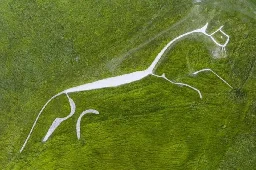
- ‘Humongous’ fort found in Wales may disprove theory of Celtic-Roman peacewww.theguardian.com ‘Humongous’ fort found in Wales may disprove theory of Celtic-Roman peace
Site in Pembrokeshire suggests area was more militarised than previously thought, says expert who made discovery
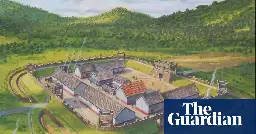
> A previously unknown Roman fort discovered in Pembrokeshire in Wales overturns assumptions that the area’s indigenous Celtic tribe was on peaceful terms with the Roman invaders. > >The site, which has excited archaeologists, had been hidden until now beneath an enormous, overgrown field. It explains why the land had been unsuccessful for farming: the farmer kept hitting stone. > > The discovery was made by Dr Mark Merrony, a leading Roman specialist and tutor at Oxford University, who said: “It is a humongous fort, an incredible find of national importance.” > >He is all the more excited because it is right next to a Roman road that he has also identified for the first time. > >The fort is thought to date from the first to the third centuries, when the Celtic Demetae tribe inhabited the south-west area of modern Wales. > >They were thought to have been pro-Roman, meaning there was less need for a major military presence to quell local resistance. > >Merrony said that this fort suggested this part of Wales was considerably more militarised than previously thought: “I now don’t think they were pro-Roman at all, but that the Romans were hitting the area with an iron fist.” > >He noted that its form and scale was like the only other Roman fort known in Pembrokeshire, excavated at Wiston near Haverfordwest in 2013. Both forts were now linked to a Roman road network that had not previously been known, he said.
- Archaeological Find Supports Ancient Greek Explorer’s Account of Britons
> The recent discovery of more than 600 red ochre fragments at a 6,500-year-old ceremonial site near Carlisle, northwestern England, supports an ancient Greek explorer’s account from the 4th century BC in which Britons are referred to as “the painted people.” > >Pytheas of Massalia, an explorer from the Greek colony that is modern-day Marseille in southern France, was quoted by later geographers to have spoken of Great Britain as Prettanike, a term derived from the Celtic word Pretani, meaning “the [land of the] painted ones” or “the tattooed folk.” > >Julius Caesar, writing in the mid-1st century BC, also mentioned that the inhabitants of Britain had a tradition of painting themselves. > > The Carlisle red ochre discovery—the largest find of red ochre pieces found yet in the UK—not only complements the linguistic evidence on ancient Britons’ tradition of body painting but also suggests a long-held gathering or festival which featured body painting rituals, according to The Indepenent. > >A number of stones that would have been used to grind ochre deposits into powder were also found along hundreds of thousands of fragments of flint. > > Additional findings support the idea that the people that gathered at the Stone Age site in Carlisle, most probably during the salmon-fishing season in spring, originated from across Britain. > > ... > > Pytheas of Massalia was the first-ever Mediterranean to reach and explore Great Britain and the Arctic Circle. > >He is believed to have traveled as far as Iceland, becoming the first person on record to describe the midnight sun and the first known scientific visitor to see and describe the Celtic and Germanic tribes.
- Horse burial, medieval items and more fascinating finds unearthed by archaeologists at former M&S site, Stodman Street, Newarkwww.newarkadvertiser.co.uk Fascinating archaeological finds unearthed at former M&S
A horse burial and a range of medieval items have been discovered during work to transform Newark’s former M&S.
> For the past few weeks, the site of redevelopment work at 32 Stodman Street has been host to an archaeological dig by a specialist team from Contour Archaeology Ltd to ensure nothing is missed before building work commences. > >The team have explored the history of the town dating back to the medieval period, to develop an understanding of the historical events that occurred on the site, and its place within the history of the town. > > Archaeology work has identified Medieval features including walls, wells, enclosure boundaries and pits, one of which contained the fully intact horse burial. > >Other finds across the site include roof tiles, pottery, metalwork, and animal bones, such as boar’s tusks as well as cow and sheep bones, which indicate the type of diet medieval people of Newark would have eaten. > > Other smaller items are thought to date back as far as the Anglo-Saxon period — with further investigation into this period set to take place.
- Early human life in Kent revealed at archaeological dig near Faversham unearthing artefacts from Neolithic and Bronze Agewww.kentonline.co.uk Secrets unearthed at huge ancient burial ground in Kent
Archaeologists are finding out more about prehistoric life in Kent at one of the country’s largest burial grounds even older than Stonehenge.
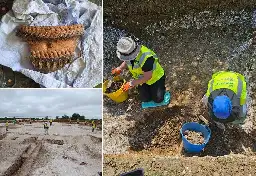
> Archaeologists are finding out more about prehistoric life in Kent from 5,000 years ago at one of the country’s largest ancient burial grounds. > >Experts say the multi-year dig at Stringmans Farm on the Lees Court Estate, near Faversham, has uncovered artefacts dating back to the Neolithic or Bronze Age period. > > The community excavation project led by a team from the Kent Archaeological Society unearthed a selection of items including flint chippings (leftovers from making stone tools), fragments of rare, decorated pottery created 3,000 years before the Romans came to Kent, and evidence of human prehistoric cremations.
- Archaeologists are hugely excited by the discovery of an ancient monument on the outskirts of a Wigan village
> Wigan Archaeological Society members have been unearthing ancient treasures and revealing a previously unknown monument thought to date back to 1650 BC on open land at Aspull. > >The enigmatic site first came to their attention in 2019, when a near-circular cropmark was spotted in overhead images seen online. > > At first it was thought it might represent the remains of a barrow (burial mound) but investigations were hampered for a long time by the pandemic. > > The site – which the archaeologists first called Aspull Ring Feature – lies within sight of Winter Hill and Anglezarke Moor, areas rich in prehistoric monuments and it was thought they might be connected. > > There then followed the digging of a series of exploratory trenches, the first of which concluded that the area had been a ditch was deliberately filled in so they changed its name to Aspull Ring Ditch. > >Further trenches established the shape of the ditch and uncovered a carefully built structure of alternating layers of sand, rounded stones, and clay. Helpfully, at least two long pieces of burnt wood were also involved in its make-up, allowing experts to take samples for radiocarbon dating which gave them a date from the middle Bronze Age: 1650 BC. > > By the close of the 2022 season, they had working theory that the feature had originated as a Neolithic henge monument, which was then repurposed during the Bronze Age, possibly as a funerary enclosure (mortuary). > > ... > > A spokesperson for the society said: “While there are still many puzzles and conundrums to unravel at this site, there are two finds that so far defy explanation. > > "The first is an irregular stone ball covered with brown and white patinas that hinder identification of the rock type, but it might be granitic, and is certainly not local. > >“Our second enigma is a stone inscribed with three deep, parallel grooves, 9mm apart. Then another one turned up, this time with four parallel grooves spaced 8.4mm apart. Better still, it was found in a carefully excavated section, meaning that we can tell it was definitely beneath the burnt layer dated to 1820 BC. Like buses, a third example duly appeared, again in a certain prehistoric context and this time with eight grooves 10mm apart. > >“In each case, the grooves are precise and deep, unlike, for example, sharpening stones, where the grooves tend to be at random angles and anything but precise. What they mean, though, is truly mystifying.
- Archaeologists restore profile of Britain’s oldest chalk figurewww.indy100.com Archaeologists restore profile of Britain’s oldest chalk figure
National Trust and Oxford Archaeology have completed work to restore the head and neck profile of the Uffington White Horse.

> Archaeologists have given Britain’s oldest chalk figure a facelift, with work to restore the head and neck profile of the Uffington White Horse in Oxfordshire. > >Archaeological work last year, including examination of previous surveys, showed that parts of the ancient chalk horse carved into the hillside have narrowed over time, as grass has encroached and topsoil slipped. > >The head and neck area of the 3,000-year-old figure had narrowed to less than half its typical width. > > Now archaeologists from the National Trust and Oxford Archaeology have returned the 364ft (111m) long horse, which dates from the Bronze Age, to its typical profile, by carefully cutting the encroaching turf back to the estimated original edge and re-distributing some of the top layer of chalk on the figure. > >During the work, soil samples from the lowest layers of the figure have also been taken to see if they can be used to accurately date its creation. > > Previous samples taken in the 1990s revealed the horse to be Britain’s oldest chalk figure, but techniques to date archaeological remains have improved so there is an opportunity to refine the date further, the team said.
- Archaeological evidence shows centuries of intensive economic growth in Britain under Roman rulephys.org Archaeological evidence shows centuries of intensive economic growth in Britain under Roman rule
A team of anthropologists and behavioral specialists from several institutions in the U.S., working with a colleague from the U.K., has found that following the conquest of Great Britain in AD 43 by the Romans, the region experienced intensive economic growth.

> In their study, published in the journal Science Advances, the group studied three types of archaeological evidence collected from multiple sites across the U.K. to measure economic growth. > > Over the past several decades, the U.K. has enacted laws requiring archaeological investigations on land under development. These studies have led to a large number of archaeological finds. For this new study, the researchers used data from such finds to measure the economic impact of Roman conquest and occupation over hundreds of years approximately 2,000 years ago. > > To gain insight into how Roman rule may have impacted Britain, the research team looked at three types of artifacts: buildings, coins and pottery. More specifically, they looked at how such artifacts changed in the years after the Roman conquest. Houses got bigger, they noted, and as people grew richer, they became more careless with their coins, resulting in more of them being lost between floorboard cracks. > > As living standards improved, so did the quality and diversity of pottery used for preparing and eating meals. In making such comparisons, the research team was able to watch how economic growth impacted the people who had been conquered. > > They found that in many cases, it had been what they describe as intensive—it greatly exceeded the type of growth that would have been expected for the region if the Romans had not arrived with their advanced technology and rules of business conduct. > > In their study, published in the journal Science Advances, the group studied three types of archaeological evidence collected from multiple sites across the U.K. to measure economic growth. > > Over the past several decades, the U.K. has enacted laws requiring archaeological investigations on land under development. These studies have led to a large number of archaeological finds. For this new study, the researchers used data from such finds to measure the economic impact of Roman conquest and occupation over hundreds of years approximately 2,000 years ago. > > To gain insight into how Roman rule may have impacted Britain, the research team looked at three types of artifacts: buildings, coins and pottery. More specifically, they looked at how such artifacts changed in the years after the Roman conquest. Houses got bigger, they noted, and as people grew richer, they became more careless with their coins, resulting in more of them being lost between floorboard cracks. > > As living standards improved, so did the quality and diversity of pottery used for preparing and eating meals. In making such comparisons, the research team was able to watch how economic growth impacted the people who had been conquered. > > They found that in many cases, it had been what they describe as intensive—it greatly exceeded the type of growth that would have been expected for the region if the Romans had not arrived with their advanced technology and rules of business conduct.
- Archaeologists to dig for medieval wooden building on Silloth farmwww.bbc.com Archaeologists to dig for medieval wooden building on Silloth farm
One theory put forward is the potential timber structure was once a barn belonging to monks.
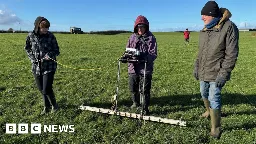
> Volunteers are set to take part in a 12-day archaeological dig in the hope of finding signs of medieval life on a farm. > > The excavation at High Tarns Farm in Silloth will begin on 22 July. > > It will be led by archaeologist Mark Graham and follows his discovery of crop marks on the land, which suggest it was once the site of a large medieval building. > > Mr Graham said he was "excited" but warned it could be a let down, adding: "If you're going to be an archaeologist, you better get used to disappointment." > > Due to written records, archaeologists have long known that part of the town was once the site of a medieval farm linked to Cistercian monks. > > ... > > The marks looked like a "footprint of a large timber building", he said, adding: "I nearly fell off my chair." > > He suspected the building was timber as the marks corresponded with holes required for large wooden posts to hold up such a structure. > > No such building is detailed in maps going back to the 1800s, he added, and the marks suggest the building is about 50m (164ft) long and 20m (66ft) wide. > > Mr Graham's two main theories about the potential building are that it was once a barn belonging to the Cistercian farm, or it is even older and was the home of a Viking chieftain. > > "There have been houses on the scale that we're talking about excavated in Scandinavia but to find such a thing here in Cumbria would be absolutely remarkable," he said.
- "My Excalibur Moment": Discovering A 16th Century Sword On A London Beach
> In an extract from her new book, A Mudlarking Year: Finding Treasure in Every Season, Lara Maiklem describes the thrill of discovering a 16th century sword on a Bankside beach. > > Thursday 2 February 2022 > > I hear from the Museum of London today about the 'sixteenth-century bladed object' I found last year. My Excalibur moment happened at the beginning of December on a murky Saturday afternoon. I don't usually mudlark on the weekend — the foreshore is often busier and I try to keep weekends for family time — but I was in London meeting friends for lunch that day, and as I made my way back to the station, I saw the tide was low. Actually, I knew the tide was low, which is why I took the longer route along the river to the station. How could I not? I only briefly considered my new brogues, which were entirely unsuitable, before unlatching the metal gate and taking the concrete stairs down onto the foreshore at Bankside. The light was fading, and I knew I didn't have long before I lost it altogether, so I headed straight for my favourite patch. People were already there, and I could see from the footprints that it had been well searched, so I walked a little further along and that's when I saw it. > > ... > > The handle and hilt loomed out at me from a small area of gritty sand that thinly covered the mud into which the blade disappeared. What caught my eye was its regular shape and the two lines of twisted gold wire embedded in the dark brown material of the handle. The blade was only just beneath the surface, and I gently cleared away the sand until I felt the end of it with my fingers. Easing my hand carefully underneath, I lifted it free quite easily, leaving a perfect impression of where it had lain for the best part of 500 years in the dark grey mud. I held the sword aloft. Excalibur of the Thames! And looked around, but everyone had gone and there was nobody to share the moment with. The handle looked to be made of wood with a square pommel carved into the end, finished off by a four-petalled flower or quatrefoil in what I assumed was copper alloy. The blade was broken at about eight inches long and was encrusted in a thick layer of mud, pebbles and rust. When iron rusts, it often engulfs whatever is lying next to it in the mud and ends up looking like a giant caddisfly larva case. If it had been a Victorian padlock or an old horseshoe, I would have been tempted to knock the concretion off with a stone, but this was too precious.